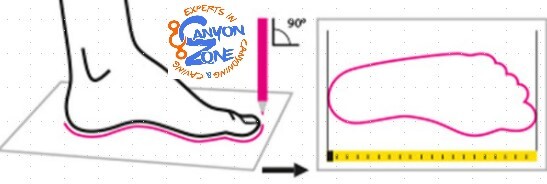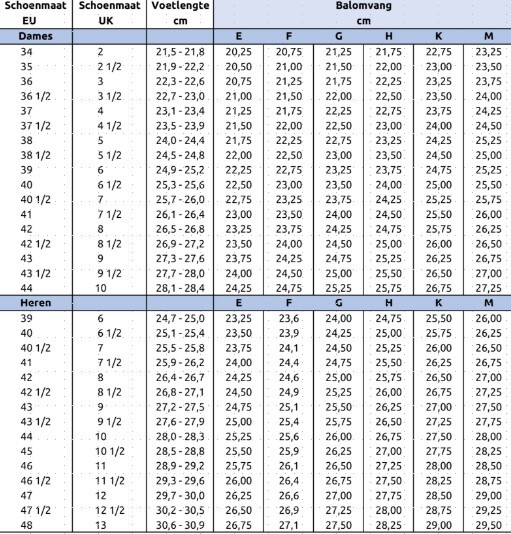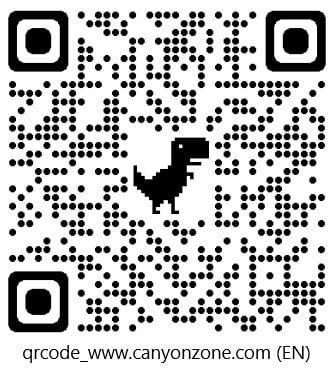Which shoe size do I need?
To determine that, we first need to establish when your shoes, in general, fit most people best.
The shoe size is related to the length of the foot.
Not only the right shoe size (ie shoe length), but also the right shoe width determines the wearing comfort of a shoe.
When determining the ratio between the length and width of the shoe, the shoe industry uses averages. With wide or narrow shoes, a letter is often added to the shoe size (E, G, H, K or M).
Foot Length:
Choosing the right length size
Most shoes run true to size.
Furthermore:
- If you normally wear half sizes, but the model is only available in full sizes, please order the next larger size.
- If one foot is larger than the other, always choose the size of the larger foot. Then use forefoot insoles.
- If the (comfort) shoe is one last wider than you normally wear, for example an H-last instead of your usual G-last, take half a size smaller (see below for an explanation of the width measurements).
If you are not sure about your size, you can measure your foot with centimeters as shown in the foot measurement picture. You start from the longest toe (this can also be the 2nd toe).
HOW DO I DETERMINE MY SHOE WIDTH?
Selection of the correct width
A width is an indication of the width of a shoe at the height of the ball and instep of the foot, so a combination of ball circumference and instep circumference, and indicates how much space the foot has in the shoe. You can recognize a width by the letter or number.

The shoe width can differ on the left and right (as usually the shoe size, i.e. the shoe length between the left and right foot varies). In general, right-handed people have their right feet slightly wider and vice versa. It is therefore best to measure both feet. If you lack the time or willingness to do so, you can measure your right foot as a right-hander and your left foot as a left-hander. Without exception, the size of the wider foot determines which shoe width you should choose for your shoes.
- Measure the width of your foot (without sock) using a tape measure while standing. As an alternative to a tape measure, you can also use a lace or cord and measure it later with a ruler.
- It is best not to measure the shoe width in the morning, but in the afternoon or evening, because then the foot has the relevant width. Due to the load of the day and the correspondingly stronger blood circulation, it increases in volume. And because you want your shoes to fit perfectly even in the evening, that is exactly the right time to measure the foot width.
- Try to distribute your weight evenly on both feet, otherwise the heavily loaded foot will become wider. For an accurate measurement, it makes sense to have your foot width measured by a second person.
- Place the tape measure all the way around your foot at the widest point of your soccer ball. Hold the tape measure loosely. The ball of your foot is the point where friction or painful pressure points first appear (the ball of the foot is under the forefoot).
- You can now compare the measurement result of your shoe width with the shoe width table below.
Shoe width table

If your shoe width is between two values, choose the next higher value.
What is a Normal Foot Width?
Shoe widths E and F are suitable for narrow feet.
Shoe width G is a comfortable width for people who wear shoes with a normal width.
Shoe width H is recommended for firm feet.
The shoe widths K, L and M are comfort widths and are especially recommended for very wide feet.
Which shoe suits me?
Not all brands that produce outdoor sports shoes mention the shoe width.
The following can be roughly stated for the canyoning shoes in the Canyonzone range:
- Narrowest shoe last: La Sportiva
- Regular lasts: Adidas and Fitwell
- Wide lasts: Bestard and Etché
If in doubt, please get in touch.
If desired, see also:
Overview Knowledge base General canyoning and caving equipment : Go back.
CanyonZone
-
- Experts in canyoning & caving gear - ship worldwide
-
- New items in assortment
- Special offers
- Pre-ordering 2025
- NEW - Petzl Canyoning / Caving Line 2025
- 2nd hand canyoning caving articles
- Items / packages customer specific
- Giftcards of CanyonZone
-
- Canyoning (basic) equipment
- Canyoning equipment packages
- Luggage / Travel Bags
-
Canyoning Neoprene clothing
- Size charts by Brand
- Aventure Verticale (AV) size charts
- CE4Y neoprene size charts
- GUARA neoprene size charts
- Seland neoprene clothing size charts
- Newex neoprene size charts
- NRS neoprene size charts
- Vade Retro neoprene size charts
- Custom made neoprene wetsuit, required size data
- Canyoning Wetsuits
- Protective Canyoning Clothing
- Canyoning Neoprene Headgear
- Canyoning Drysuit / Undersuit
- Canyoning Neoprene shirts & shorts
- Canyoning Knee - elbow protectors / pads
- Canyoning Neoprene gloves
- Canyoning Neoprene socks
- Canyoning shoes
- Harnesses & Accessories
- Helmets outdoor sports
- Carabiners & maillons
- Descend devices
- Ascending / Rise along rope
- Pulleys
- Rope & webbing slings
- Anchoring & accessories
- Via Ferrata / Klettersteig sets
- Outdoor Gloves / (ice-)canyoning, caving, via ferrata
- Canyoning Back Packs, bags & duffels
- Drybags & Kegs, Boats
- Outdoor Knives & Scissors
- Safety in outdoor sports
- First Aid / Medical Articles
- Rescue in outdoor sports
- Camping, Bivouac & Backpacking
- Winter- / Ice Canyoning
-
Canyoning Books & Topographic Maps
- Map Pouch
-
Canyoning Guide Books
- Australia
- Austria
- France (including Corsica and La Reunion)
- Germany
- Greece (including Crete) / Balkans
- Israel
- Italy (including Sardinia)
- Jordan / Middle East
- Morocco
- New Zealand & Australia
- Portugal (including Madeira and Azores)
- Scandinavia
- Slovenia
- Spain (including Canary Islands and Majorca)
- United Kingdom (UK) / Scotland
- United States of America
- South America
- Switzerland
- Turkey
- Canyoning Techniques & Skills
- Canyoning Maps
- Outdoor Children's Books
- Outdoor DVDs
- Via Ferrata / Klettersteig books
- Repair & Maintenance
- Miscellaneous items outdoor sports
-
- Especially for Ladies
- Especially for Children
- Especially for Instructors and Guides
- Especially for Outdoor Sports Companies
- Especially for Underwater / Cave diving / Diving
-
- Caving (basic) equipment
- Caving equipments packages
- Caving Suits / Overalls
- Caving Under Suits
- Caving Boots / Wellies
- Caving Socks
- Caving Knee- and Elbow Pads
- Caving Gloves
- Headlamps & torches
- Caving Bags & BackPacks
- Tents and Bivi bags
- Caving & Potholing Books
-
-
Climbing related gear: on request
-
- Services
-
- CanyonZone New(s)
- CanyonZone Customer Service
- Contact about Assortment
- Business ordering at CanyonZone
- About CanyonZone
- CanyonZone's FAQ
- CanyonZone's Knowledge Base
- About CanyonZone, owner Gertjan van Pelt
- Works together with
- Link exchange
-
- Privacy
- Terms and Conditions
-
Terms and Conditions Rental
-


